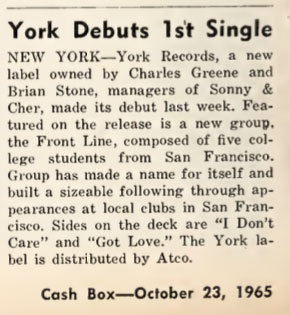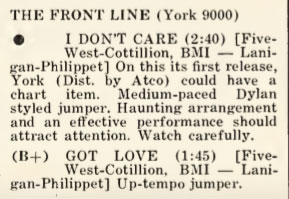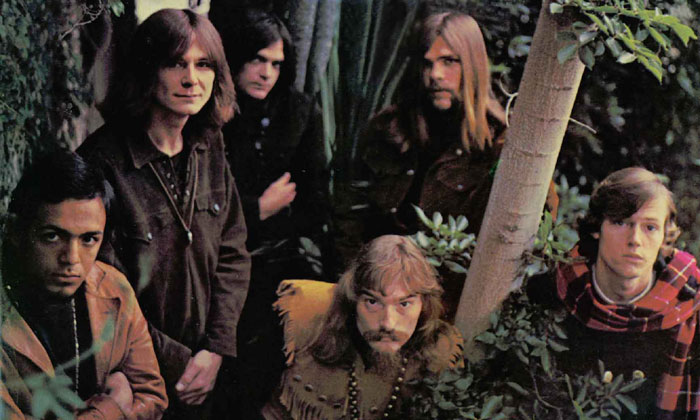

Cliff De Young (vocals)
Bob Seal (lead guitar, vocals)
Doug Lubahn (bass)
Ralph Schuckett (keyboards)
Dallas Taylor (drums)
Michael Ney (drums)
Robbie Robison (guitar)1966
Georgia-born guitarist Bob Seal teams up with Dallas Taylor (b. 1948, Denver, Colorado, US) during the summer when they meet in Phoenix, Arizona as Seal is heading to California. Taylor has already tasted the Sunset Strip scene while drumming with Lowell George’s Factory some months earlier.
They arrive in Los Angeles and set up camp in Manhattan Beach where they meet up with Robbie Robison (real name: Clyde Edgar Robison) and Michael Ney at a Peanut Butter Conspiracy gig. Robison is the husband of Barbara Robison (aka Sandi Peanut Butter), the Peanut Butter Conspiracy’s lead singer – and had recorded an album in 1964 as Robbie the Werwolf – Live at the Waleback Club.
Deciding to make a go of forming a group with two drummers they recruit Wanda Watkins as an additional vocalist and name themselves The Garnerfield Sanitarium.
In late 1966, Doug Lubahn (b. Colorado, US), who has spotted Seal and Taylor on Fairfax Avenue wearing signs reading “Seeking singing, writing bass player” joins on bass. Lubahn had moved to Los Angeles a few months earlier from Aspen, Colorado where he was working as a ski instructor and playing with several local groups. He is spotted by Mama Cass of The Mamas & The Papas and she encourages him to relocate to the West Coast.
They acquire Bud Mathis as manager and change name to the Brain Train – a name given to them by the Peanut Butter Conspiracy’s Alan Brackett. In the process they lose Watkins, who will turn up in another Bud Mathis outfit, The Joint Effort. Mathis finances a recording session at the Electro Vox Studios and takes the resulting demo recordings of Wolfang Dios’ “Black Roses” and Lubahn and Mathis’s “Me” to Elektra Records.
1967
Elektra snaps the band up but persuades them to ditch Mathis and be taken under the wing of producer Paul Rothchild. The Brain Train moves into a large house on Franklin Avenue in the Los Feliz area of Los Angeles, which has previously been the home of WC Fields and begin reheasing material for their proposed album.
March (26) Renamed Clear Light, the band plays at Los Angeles’ first “Love-In” at Griffith Park on the same bill as The Steve Miller Band, The Grateful Dead and The Other Half.
April The recording sessions for the band’s debut album begins. Two of the first tracks completed are a reworking of “Black Roses” and a Robbie Robison composition titled, “She’s Ready To Be Free”. Around the same time, the group lands a cameo role in the movie, The President’s Analyst starring James Coburn. Soon after filming, Clear Light adds lead singer Cliff De Young (b. 12 February 1945, Los Angeles, California, US).
Scene from The President’s Analyst
Barry McGuire cast as their singer, for some reason.
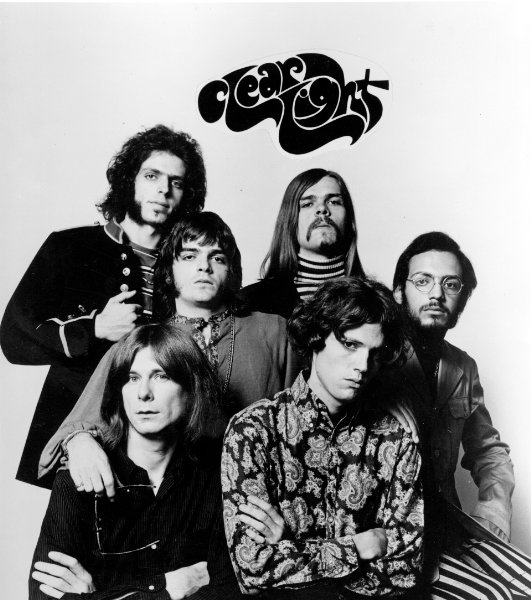
(30) The group performs at the “Freedom of Expression Concert” at the Hullabaloo, Hollywood, alongside The Doors, Canned Heat, The Poor and many others.
May Despite having put down most of the tracks for the album, Elektra decides that Robison’s acoustic approach is incompatible with the group’s new electric direction and he is dropped from the group, although he remains part of the entourage, operating his own light show, set up at the group’s live appearances. After auditioning many guitarists as possible replacements, including Doug Hastings (ex-Daily Flash and soon-to-be Buffalo Springfield) they eventually decide to go with keyboard wunderkind Ralph Schuckett. Schuckett overdubs keys to several of the tracks already in the can as well as collaborating with fellow newbie Cliff De Young.
June (11) The new line up performs at Cheetah, Venice, California with Kaleidoscope.
(30) The band performs at the Oracle Benefit at the Valley Music Theatre, Los Angeles with Kaleidoscope and The Fraternity of Man (the Byrds cancel – McGuinn was sick). After this Clear Light embark on a cross country tour driving non-stop to Philadelphia where the band goes on strike, forcing Elektra to fly them to New York. The group is met by Danny Fields, who checks the musicians into Albert’s Hotel. The band initially plays at Steve Paul’s Scene East in the Delmonico Hotel but on the first night Schuckett lambasts the crowd for not paying attention to the group’s performance and it is fired. The next day, Steve Paul places the group at his main club, The Scene.
July (6-23) Clear Light play at Steve Paul’s Scene, New York. While there, the group jams with various guests including Tiny Tim, Howlin’ Wolf and The Candy Men, formerly members of The McCoys. The band plays further dates in Boston before returning to Los Angeles.
August (31) – September (3) Clear Light performs at the Magic Mushroom, Los Angeles with Kaleidoscope. Soon afterwards, the band’s debut single, “Black Roses” c/w “She’s Ready To Be Free” is released.
(25) Lubahn participates in the sessions for The Doors’ Strange Days album.
(30) Clear Light appears at the Earl Warren Showgrounds, Santa Barbara with The Quicksilver Messenger Service, Van Morrison and Blue Cheer.
October (20-22) The band plays at the Cheetah, Venice, California with The Electric Flag.
(26-28) The group supports Lee Michaels and Pink Floyd at the Fillmore Auditorium, San Francisco.
November The group’s eponymous debut album is released climbing to US #126. The band’s second single, “They Who Have Nothing” c/w “Ballad of Freddie & Larry” is issued to support the album. The debut longplayer is subsequently released in the UK, and although it is not a hit, it is greeted with interest, particularly on the underground scene. (Clear Light’s records are regularly featured on John Peel’s Top Gear). Bud Mathis licences The Brain Train demos to Titan Records in order to cash in on the release of the Elektra album.
(8) Clear Light appears on Pat Boone’s weekly show Pat Boone in Hollywood.
(17-19) They play at the Cheetah in Venice, California with The Nazz.
(22) Clear Light performs at the Santa Monica Civic Auditorium, Santa Monica, California with The Peanut Butter Conspiracy, The Merry Go Round, The Hour Glass and others.
(25) They appear at the Earl Warren Showgrounds in Santa Barbara, California with The Youngbloods, Canned Heat and The Merry Go Round.
(30) – December (2) The band is joined by The Nitty Gritty Dirt Band for a series of shows at the Fillmore Auditorium.
(8-9) They play at the Boston Tea Party, Boston with The Street Choir.
(19-31) Clear Light perform at the Café Au Go Go in New York where they are joined by Tim Buckley on the 28th and 30th. After much behind the scenes manipulation and Svengali–ism by Rothchild, the band starts auditioning guitarists, including Kenny Pine and Jeff Jacobs, on the club’s stage to replace Bob Seal, who has come to blows with the producer. Danny Kortchmar, who has previously played with New York groups, The King Bees and The Flying Machine and recently returned from Los Angeles where he had tried out for Elektra’s project supergroup (later Rhinoceros) takes over lead guitar. Seal meanwhile relocates to the Bay area and, disillusioned with playing six string takes up the bass – gigging but not recording with Gale Garnett & The Gentle Reign. He later takes up the six string again, replacing the original guitarist in the Transatlantic Railroad. He subsequently teams up with former Salvation member Joe Tate in Redlegs, a popular Bay Area group.
1968
January (5-6) With Kortchmar on guitar, Clear Light play at the Grande Ballroom, Detroit with Gypsy and Children.
February A third single, “Night Sounds Loud”, is only released in the UK, but is not a hit.
(23-24) Clear Light support Jefferson Airplane at the Shrine Auditorium, Los Angeles with the Ceyleib People.
(26 & 28) Kortchmar, Schuckett, Lubahn and Ney appear on the recording of The Monkees’ “The Porpoise Song”, produced by Russ Titelman and Gerry Goffin. Also on the session are Leon Russell and British jazz pianist, Victor Feldman.
March (17) Clear Light plays at Pasadena Exhibition Hall, Pasadena, California with The Peanut Butter Conspiracy, Iron Butterfly, Steppenwolf, Procol Harum and many others.
(24) The group joins The Buffalo Springfield, Jefferson Airplane, H.P. Lovecraft, The Quicksilver Messenger Service and various others at a benefit for the Radio Strike Fund for disc jockeys at KPPC Pasadena and KMPX San Francisco.
(29-30) The band appears at the Kaleidoscope with Bo Diddley and The Peanut Butter Conspiracy.
April (13) Clear Light appears at the Salt Lake Coliseum, Salt Lake City, Utah with Blue Cheer and Jerry Abrams.
(18-23) Clear Light plays at the Cheetah, New York with Harvey and The 7 Sounds.
(26-28) The band appears at the Trauma in Philadelphia with The Mandrake Memorial.
May (3-4) The group performs at the Boston Tea Party with Butter and Tim Rose. The group then returns to New York and plays some shows at the Electric Circus with The Chambers Brothers and Circus Maximus where they are a huge hit.
(25) Clear Light plays at the “McCarthy Happening” in Santa Clara County Showgrounds, San Jose, California with H.P Lovecraft, The Nitty Gritty Dirt Band, The Flamin’ Groovies, The Strawberry Alarm Clock, Crystal Syphon, Womb and others.
(30) Kortchmar takes part in the recording of The Monkees’ “As We Go Along”.
June (14-16) The band appears at San Francisco’s Avalon Ballroom with Frumius Bandersnatch and Buddy Guy. Sessions for a second album begin but after a few recordings Cliff De Young quits to return to college. He later pursues an acting career. Two tracks from the sessions survive – “Darkness of Day” (a Schuckett/De Young collaboration) and Kortchmar’s “What A Difference Love Makes”.
August Kortchmar appears on The Fugs’ album, It Crawled Into My Hand Honest.
September Clear Light unofficially splinters. Lubahn briefly becomes The Doors’ studio bassist, appearing on albums Waiting For The Sun and The Soft Parade before forming jazz/rock band, Dreams with ex-Blood, Sweat & Tears member Randy Brecker, while Schuckett and Ney (in the guise of Mike Stevens) join The Peanut Butter Conspiracy for a summer and winter tour of the Pacific Northwest. Schuckett also does session work for people like James Cotton. Dallas Taylor, who initially works with ex-Lovin’ Spoonful singer/guitarist John Sebastian is subsequently introduced to Stephen Stills. Around this time, Taylor, Lubahn and Schuckett do a recording session with Stills at TTG studio in Hollywood. Taylor strikes up a rapport with Stills and is chosen as drummer for Crosby, Stills & Nash.
November Kortchmar and Ney join Carole King’s City, although the latter will soon be replaced by Jim Gordon.
1969
January Elektra’s news letter, Revelation announces that Clear Light have split up.
February The City’s sole album, Now That Everything Has Been Said is released on Lou Adler’s Ode label.
December Taylor appears on Essra Mohawk’s album, Primordial Lovers, released on Reprise Records.
1970
May (12) Taylor is sacked by Crosby, Stills, Nash & Young after a gig in Denver and rejoins John Sebastian’s backing band.
September Schuckett and Kortchmar reunite in Jo Mama, which signs to Atlantic Records.
November Lubahn’s group Dreams release their eponymous debut album.
1971
March Debut Jo Mama album, O Sole Mio is released. Schuckett also appears on Carole King’s Tapestry album and follows this with two US and one UK tour with James Taylor in support.
September Taylor appears on John Sebastian’s Four Of Us, before joining Stephen Stills’s Manassas.
November Second Jo Mama album J Is For Jump is released, but is not a success and the band splinters. Kortchmar works for David Crosby and Graham Nash, while Schuckett does sessions for Todd Rundgren amongst others.
1972
Lubahn appears on the Everly Brothers album Stories We Could Tell.
May Manassass’ eponymous debut double album is released.
October After doing a multitude of sessions for people like Crosby & Nash, Kortchmar forms The Section, who release their eponymous debut album on Warner Brothers.
1973
Cliff De Young stars in the TV film Sunshine and subsequently releases a soundtrack album featuring songs by John Denver on MCA.
September A second Section album, Forward Motion is released but is not a success. Kortchmar leaves to record a solo set Kootch.
May A second Manassas album Down The Road is issued, but the group splinters soon after and Taylor moves into session work, appearing on albums by people like Bill Wyman and Sammy Hagar, before rejoining Stephen Stills’s backing group.
1974
Cliff De Young releases an eponymously titled solo album on MCA. He continues to be in demand as a film and TV actor.
December After doing various sessions for people like David Blue, Carole King and Todd Rundgren, Schuckett becomes part of the latter’s Utopia. He will remain with the band for two years appearing on the albums Todd Rungren’s Utopia, Initiation and Another Live.
1975
September Kortchmar joins Crosby & Nash’s backing band, The Mighty Jitters, and subsequently appears on their albums Wind On The Water, Whistle Down The Wire and Crosby/Nash Live.
1976
June Schuckett appears on a recording by Free Beer, who release the album Highway Robbery on RCA.
July Kortchmar forms The Attitudes, releasing an eponymous debut on George Harrison’s Dark Horse label.
1977
March Schuckett appears on a second Free Beer album, Nouveau Chapeau. Lubahn forms new a group, Pierce Arrow, with ex-Dreams member Jeff Kent and ex-Compton & Batteau guitarist/vocalist Robin Batteau. Schuckett fills in for Jeff Kent when he recouperates from a serious injury in 1978.
October Pierce Arrow issue an eponymous debut for CBS. A second Attitudes’ album Good News is also released, but is not a success and Kortchmar returns to session work.
1978
July A second Pierce Arrow album Pity The Rich is released, but is not a success and Lubahn leaves to pursue other projects.
1980
Schuckett joins Ellen Shipley’s backing group and continues to do session work for such notable artists as Cher. Lubahn writes Treat Me Right for Pat Benatar, which appears on her album, Crimes of Passion.
August Kortchmar meanwhile, releases second solo album, Innuendo, on Asylum Records.
1981
Lubahn forms Riff Raff who release the album Vinyl Future for Atlantic. He subsequently joins the Billy Squier band.
1982
Lubahn appears on Billy Squiers’ Emotions in Motion.
October Kortchmar appears on ex-Eagle Don Henley’s debut solo album I Can’t Stand Still, which he also co-produces and co-writes several songs on. The pair will strike up a rapport and Kortchmar will become an integral part of Henley’s backing band for the next ten years.
1984
Schuckett produces an album for Clarence Clemons for Columbia Records. He also co-produces two tracks with Bruce Springsteen. Lubahn apears on Ted Nugent’s Penetrator and Billy Squiers’ Signs of Life. He also writes Talk To Me – recorded by Patty Smyth and Scandal on their album Warrior (which features Schuckett).
1987
September British indie label, Edsel issues Clear Light’s album with the bonus cut “She’s Ready To Be Free”. In 1991, Lubahn sings background vocals on Billy Squier’s album, Creatures of Habit.
Sources:
Einarson, John and Furay, Richie. For What It’s Worth – The Story Of Buffalo Springfield. Quarry Press Inc, 1997.
Grushkin, Paul D. Art Of Rock – Posters From Presley To Punk, Artabras, Cross River Press Ltd, 1987.
Hogg, Brian. Sleeve notes to Edsel’s reissue of Clear Light, 1987.
Hounsome, Terry. Rock Record #6, Record Researchers Publications, 1994.
David Peter Housden. The Castle – Love #9, page 63.
Joynson, Vernon. Fuzz, Acid & Flowers, 1993.
Long, Pete. Ghosts On The Road – Neil Young In Concert, Old Homestead Press, 1996.
Sandoval Andrew. Sleeve notes to Rhino’s reissue of The Monkees’ album Head, 1994.
Shaw, Greg. The Doors On The Road, Omnibus Press, 1997, pages 35 and 64.
Village Voice, July 6, 1967, page 26, December 14, 1967, page 52 and December 28, 1967, page 39.
Thanks to Gray Newell for his extensive help in piecing this story together. Many thanks too to Marc Skobac for research on some of the live dates. Huge thanks also to Ralph Schuckett for filling in many of the gaps and Doug Lubahn for his input. Thanks to Marc Skobac for his corrections.
Be sure to check out the official Clear Light website.
Email: Warchive@aol.com
Copyright © Nick Warburton. All Rights Reserved. No part of this article may be reproduced or transmitted in any from or by any means, without prior permission from the author.


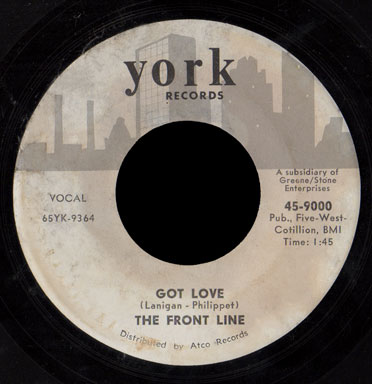 The Front Line were based in San Rafael, in Marin County, California. Members included Gary Philippet on keyboards, Bill Bowen on drums, Rex Larsen, Jim Brewer and Dennis Lanigan. Philippet had been in a few earlier bands, including the Mystics and the Pullice. Bowen and Philippet were both part of Electric Train, who recorded two songs found on an acetate but not released at the time.
The Front Line were based in San Rafael, in Marin County, California. Members included Gary Philippet on keyboards, Bill Bowen on drums, Rex Larsen, Jim Brewer and Dennis Lanigan. Philippet had been in a few earlier bands, including the Mystics and the Pullice. Bowen and Philippet were both part of Electric Train, who recorded two songs found on an acetate but not released at the time.